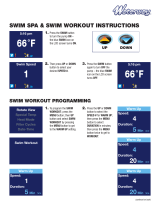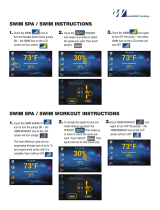
Table of Contents
Introduction.....................................................................1
Keys............................................................................................ 1
Status Icons........................................................................... 1
Going for a Run.......................................................................... 1
Charging the Device................................................................... 1
Saving Time with the Shortcut Menu.......................................... 1
Training........................................................................... 2
Multisport Activities..................................................................... 2
Changing Activity Profiles During an Activity......................... 2
Triathlon Training........................................................................ 2
Swimming................................................................................... 2
Swimming with Your Forerunner............................................2
Swimming in Open Water...................................................... 3
Activity Tracking..........................................................................3
Turning On Activity Tracking.................................................. 3
Using the Move Alert..............................................................3
Auto Goal............................................................................... 3
Sleep Tracking....................................................................... 3
Training Indoors.......................................................................... 3
Workouts.....................................................................................3
Following a Workout From the Web.......................................3
Starting a Workout................................................................. 3
About the Training Calendar.................................................. 4
Interval Workouts........................................................................ 4
Creating an Interval Workout................................................. 4
Starting an Interval Workout.................................................. 4
Stopping a Workout............................................................... 4
Viewing Your Predicted Race Times.......................................... 4
Using Virtual Partner...................................................................4
Setting a Training Target............................................................ 4
Cancelling a Training Target.................................................. 5
Racing a Previous Activity.......................................................... 5
Personal Records....................................................................... 5
Viewing Your Personal Records............................................ 5
Restoring a Personal Record................................................. 5
Clearing a Personal Record................................................... 5
Clearing All Personal Records............................................... 5
History............................................................................. 5
Viewing History........................................................................... 5
Multisport History................................................................... 5
Swim History.......................................................................... 5
Viewing Your Time in Each Heart Rate Zone........................ 5
Viewing Data Totals.................................................................... 5
Deleting History.......................................................................... 5
Data Management...................................................................... 6
Deleting Files......................................................................... 6
Disconnecting the USB Cable................................................6
Garmin Connect..........................................................................6
Using Garmin Connect...........................................................6
Bluetooth Connected Features.............................................. 6
Wi‑Fi Connected Features..................................................... 6
Navigation....................................................................... 7
Adding the Map...........................................................................7
Map Features..............................................................................7
Marking Your Location................................................................ 7
Viewing Your Current Elevation and Coordinates................. 7
Editing a Location.................................................................. 7
Deleting a Location................................................................ 7
Navigating to a Saved Location.................................................. 7
Navigating Back to Start............................................................. 7
Courses...................................................................................... 7
Following a Course From the Web........................................ 8
Viewing Course Details.......................................................... 8
Deleting a Course
.................................................................. 8
Stopping Navigation....................................................................8
ANT+ Sensors................................................................. 8
Pairing Your ANT+ Sensors....................................................... 8
Compatible Heart Rate Monitors................................................ 8
HRM-Swim Accessory........................................................... 8
HRM-Tri Accessory................................................................ 9
HRM-Run Accessory............................................................. 9
Running Dynamics............................................................... 10
Setting Your Heart Rate Zones............................................ 10
About VO2 Max. Estimates.................................................. 11
Recovery Advisor................................................................. 12
Recovery Heart Rate........................................................... 12
Foot Pod................................................................................... 12
Going for a Run Using a Foot Pod....................................... 12
Foot Pod Calibration............................................................ 12
Training with Power Meters...................................................... 12
Setting Your Power Zones................................................... 12
Using Shimano® Di2™ Shifters............................................... 13
Connect IQ™ Features................................................. 13
Downloading Connect IQ Features.......................................... 13
Downloading Connect IQ Features Using Your Computer.. 13
Widgets..................................................................................... 13
VIRB Remote....................................................................... 13
Customizing Your Device............................................ 13
Setting Up Your User Profile.....................................................13
Activity Profiles......................................................................... 13
Changing Your Activity Profile............................................. 13
Creating a Custom Activity Profile....................................... 13
Deleting an Activity Profile................................................... 14
Activity Settings........................................................................ 14
Customizing the Data Screens............................................ 14
Alerts.................................................................................... 14
Running with the Metronome............................................... 14
Using Auto Pause®............................................................. 14
Auto Lap...............................................................................15
Customizing the Lap Alert Message.................................... 15
Using Auto Scroll................................................................. 15
Using UltraTrac Mode.......................................................... 15
Power Save Timeout Settings..............................................15
Activity Tracking Settings..........................................................15
Phone Notifications................................................................... 15
Enabling Bluetooth Notifications.......................................... 15
Viewing Notifications............................................................ 15
Managing Notifications.........................................................15
System Settings........................................................................ 15
Changing the Device Language.......................................... 15
Time Settings....................................................................... 15
Backlight Settings................................................................ 16
Setting the Device Sounds.................................................. 16
Changing the Units of Measure........................................... 16
Changing the Satellite Setting............................................. 16
Format Settings....................................................................16
Data Recording Settings...................................................... 16
Device Information....................................................... 16
Specifications............................................................................16
Forerunner Specifications.................................................... 16
HRM-Swim Specifications and HRM-Tri Specifications....... 16
HRM-Run Specifications...................................................... 16
Device Care.............................................................................. 16
Cleaning the Device............................................................. 16
User Replaceable Batteries................................................. 17
Troubleshooting........................................................... 17
Support and Updates................................................................ 17
Table of Contents i





















